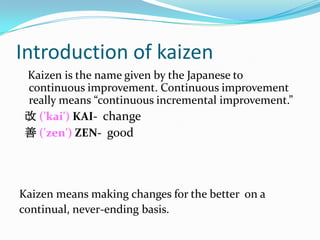Introduction of kaizen.pptx 222222222222
- 1. Introduction of kaizen Kaizen is the name given by the Japanese to continuous improvement. Continuous improvement really means Ī░continuous incremental improvement.Ī▒ Ė─ ('kai') KAI- change ╔Ų ('zen') ZEN- good Kaizen means making changes for the better on a continual, never-ending basis.
- 2. Objective of kaizen ? Role of top management --- top management is responsible for establishing Kaizen as the overriding corporate strategy and communicating this commitment to all levels of the organization and allocating the resources necessary for Kaizen to work. ? Role of middle management --- responsible for implementing the Kaizen policies established by top management; establishing, maintaining and improving work standards; ensuring that employees receive the training necessary to understand and implement Kaizen, and ensuring that employees learn how to use problem solving and improvement tools.
- 3. ? Role of supervisors --- responsible for applying the Kaizen approach in their functional roles; developing plans for carrying out the Kaizen approach at the functional level; improving communication at the workplace; maintaining morale; providing coaching for teamwork activities; soliciting Kaizen suggestions from employees and making Kaizen suggestions. ? Role of employees --- responsible for participating in Kaizen through teamwork activities, making Kaizen suggestions, engaging in continuous self-improvement activities, continually enhancing job skills through education and training, and continually broadening job skills through cross-functional training. Eg. Toyota is well-known as one of the leaders in using Kaizen. In 1999 at one U.S. plant, 7,000 Toyota employees submitted over 75,000 suggestions, of which 99% were implemented.
- 4. Scope of kaizen Reduces waste- like inventory waste, time waste, workers motion. Improves space utilization, product quality Results in higher employee morale and job satisfaction, lower turn-over. Widely acceptable-can be used in both manufacturing and non- manufacturing environments, for processes as well as people. Highly effective and success-oriented-Kaizen events will generate quick results, measurable results, establish the baseline and measure the change. A learning experience-every member of a Kaizen Team will walk away from the event learning something new
- 5. Relivance
- 6. Lean Case Study ©C░Ł▓╣Š▒│·▒▓į
- 7. ? Business: Printing ? Methodology: Kaizen ? Issue: Overrun of 700 copies a day ? delivered to mail room for dispatch. ? At 10p/copy, this equates to an annual cost of ?25,410.
- 8. Concern methodology ? Kaizen methods used to identify issues with estimating process and current practice.
- 9. Confirm solutions ? Solutions generated, and evaluated. Selected solutions implemented. ? Overrun minimised ? - Software modified ? - Edition stops added ? - Reel usage reduced
- 10. Recommendations ? Result: Overrun reduced from 700 copies to 310 copies per night on final editions and eliminated on 2nd, 3rd and 4th editions ? Impact: Process and raw material cost savings.
- 11. Conclusion ? Reduction in overrun from 700 copies to 310 copies per night resulted in annualised savings of ?14,150 and reduction of newspaper reel usage by 64 reels, equating to a cost saving of ?25,600.










